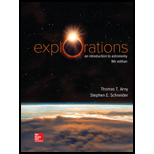
Explorations: Introduction to Astronomy
9th Edition
ISBN: 9781260432183
Author: ARNY, Thomas
Publisher: MCGRAW-HILL HIGHER EDUCATION
expand_more
expand_more
format_list_bulleted
Concept explainers
Question
Chapter 2, Problem 4QFR
To determine
The parallax and its measure.
Expert Solution & Answer
Want to see the full answer?
Check out a sample textbook solution
Students have asked these similar questions
Can someone help me with this physics 2 problem thank you.
Can someone help me with this physics 2 problem thank you.
Help
Chapter 2 Solutions
Explorations: Introduction to Astronomy
Ch. 2 - (2.1) List some observational evidence that Earth...Ch. 2 - (2.1) What is meant by the phrase angular...Ch. 2 - Prob. 3QFRCh. 2 - Prob. 4QFRCh. 2 - Where on the celestial sphere would you look for...Ch. 2 - Sketch the path on the sky that a planet makes...Ch. 2 - Will a planet in retrograde motion rise in the...Ch. 2 - Contrast the geocentric and heliocentric models.Ch. 2 - What are the three laws of planetary motion?Ch. 2 - How does astrology differ from astronomy?
Ch. 2 - Describe the major astronomical contribution(s) of...Ch. 2 - (2.1) Explain why the Moons angular size is...Ch. 2 - (2.1) Suppose the stars were very much closer than...Ch. 2 - (2.2/2.3) Tycho argued that the Sun orbits Earth...Ch. 2 - Prob. 4TQCh. 2 - Prob. 5TQCh. 2 - You may have noticed that although every 10 years...Ch. 2 - Describe how modern astrophysics differs from...Ch. 2 - Prob. 8TQCh. 2 - A small probe is exploring a spherical asteroid....Ch. 2 - Prob. 2PCh. 2 - Prob. 3PCh. 2 - Prob. 4PCh. 2 - Suppose a planet is found with an orbital period...Ch. 2 - Prob. 6PCh. 2 - Prob. 7PCh. 2 - Suppose that future observations with a new...Ch. 2 - Prob. 1TYCh. 2 - A planet in retrograde motion (a) rises in the...Ch. 2 - Ockhams razor refers to (a) a device used by the...Ch. 2 - Prob. 4TYCh. 2 - Prob. 5TYCh. 2 - Galileo used his observations of the changing...Ch. 2 - A major objection to the heliocentric model not...Ch. 2 - Do we see the same constellations today as ancient...Ch. 2 - What are right ascension and declination?Ch. 2 - Prob. 3EQFRCh. 2 - Prob. 4EQFRCh. 2 - Prob. 5EQFRCh. 2 - Prob. 6EQFRCh. 2 - Prob. 7EQFRCh. 2 - Prob. 8EQFRCh. 2 - Prob. 9EQFRCh. 2 - Prob. 10EQFRCh. 2 - Prob. 1ETQCh. 2 - Prob. 2ETQCh. 2 - Considering the orbits in figure E1.8, where would...Ch. 2 - Prob. 4ETQCh. 2 - Prob. 1ETYCh. 2 - As a star rises and moves across the sky, which of...Ch. 2 - Prob. 3ETYCh. 2 - Prob. 4ETYCh. 2 - Prob. 5ETYCh. 2 - Prob. 6ETYCh. 2 - Prob. 7ETY
Knowledge Booster
Learn more about
Need a deep-dive on the concept behind this application? Look no further. Learn more about this topic, physics and related others by exploring similar questions and additional content below.Similar questions
- Can someone help me with this physics 2 problem thank you.arrow_forwardCan someone help me with this physics 2 problem thank you.arrow_forwardTwo concrete spans of a 234 m long bridge are placed end to end so that no room is allowed for expansion (Figure a). Each span therefore has a length of L0 = 117 m. If the temperature increases by 17.8 °C, what is the height y to which the spans rise when they buckle (Figure b)? (The coefficient of linear expansion of concrete is 1.20⋅10−51.20⋅10-5 °C−1.)arrow_forward
- Monkey D. Luffy, from One Piece can inflate himself like a balloon to a size of 6.98 m3 by inhaling 1.74⋅10^26 molecules of air. If the air is at 20.9 ˚C, the pressure inside Luffy is 101277.062 Pa. kB=1.38⋅10^−23 J/K. The total internal energy of the gas inside Luffy is 1065333.93 J. How fast, on average, is the air molecules inside Luffy traveling at? The average mass of an air molecule (considering the various gasses involved) is 4.51 x 10^-26 kg.arrow_forwardThe Dungeons & Dragons spell “Stinking Cloud” fills a 949 m^3 volume of air with a cloud of gas. The pressure of the gas is the same as the air, 101,325 Pa, and is at 29.2°C. There are 2.304x10^28 molecules of gas. What is the total internal energy of the gas?arrow_forwardThe Fiero, which is 4.70 m long, starts at 10.0˚C while in the upper atmosphere but when it goes into space the temperature would be about -270.3˚C. How much should the steel siding of the Fiero shrink due to this temperature change? The coefficient of thermal linear expansion for steel is 11.0⋅10−6⋅10^-6 C-1arrow_forward
arrow_back_ios
SEE MORE QUESTIONS
arrow_forward_ios
Recommended textbooks for you
 AstronomyPhysicsISBN:9781938168284Author:Andrew Fraknoi; David Morrison; Sidney C. WolffPublisher:OpenStax
AstronomyPhysicsISBN:9781938168284Author:Andrew Fraknoi; David Morrison; Sidney C. WolffPublisher:OpenStax Stars and Galaxies (MindTap Course List)PhysicsISBN:9781337399944Author:Michael A. SeedsPublisher:Cengage Learning
Stars and Galaxies (MindTap Course List)PhysicsISBN:9781337399944Author:Michael A. SeedsPublisher:Cengage Learning Horizons: Exploring the Universe (MindTap Course ...PhysicsISBN:9781305960961Author:Michael A. Seeds, Dana BackmanPublisher:Cengage Learning
Horizons: Exploring the Universe (MindTap Course ...PhysicsISBN:9781305960961Author:Michael A. Seeds, Dana BackmanPublisher:Cengage Learning An Introduction to Physical SciencePhysicsISBN:9781305079137Author:James Shipman, Jerry D. Wilson, Charles A. Higgins, Omar TorresPublisher:Cengage Learning
An Introduction to Physical SciencePhysicsISBN:9781305079137Author:James Shipman, Jerry D. Wilson, Charles A. Higgins, Omar TorresPublisher:Cengage Learning Foundations of Astronomy (MindTap Course List)PhysicsISBN:9781337399920Author:Michael A. Seeds, Dana BackmanPublisher:Cengage Learning
Foundations of Astronomy (MindTap Course List)PhysicsISBN:9781337399920Author:Michael A. Seeds, Dana BackmanPublisher:Cengage Learning

Astronomy
Physics
ISBN:9781938168284
Author:Andrew Fraknoi; David Morrison; Sidney C. Wolff
Publisher:OpenStax

Stars and Galaxies (MindTap Course List)
Physics
ISBN:9781337399944
Author:Michael A. Seeds
Publisher:Cengage Learning

Horizons: Exploring the Universe (MindTap Course ...
Physics
ISBN:9781305960961
Author:Michael A. Seeds, Dana Backman
Publisher:Cengage Learning

An Introduction to Physical Science
Physics
ISBN:9781305079137
Author:James Shipman, Jerry D. Wilson, Charles A. Higgins, Omar Torres
Publisher:Cengage Learning

Foundations of Astronomy (MindTap Course List)
Physics
ISBN:9781337399920
Author:Michael A. Seeds, Dana Backman
Publisher:Cengage Learning

General Relativity: The Curvature of Spacetime; Author: Professor Dave Explains;https://www.youtube.com/watch?v=R7V3koyL7Mc;License: Standard YouTube License, CC-BY